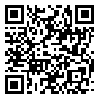Volume 2, Issue 4 (12-2013)
2013, 2(4): 25-35 |
Back to browse issues page
Isf. Univ. Technol
Abstract: (9256 Views)
Major climate changes problems in the world have attracted attentions to the phenology and have improved studies in this field. Quantitative investigation of phenology, through recording the colour of different parts of plants can be a complement for quantitative method in determining exact appearance of the phenomena. In the present study the phenological characteristics of Ailanthus altissima has been identified, using two different methods including descriptive and digital repeated photography. In descriptive observations four trees in the campus of Isfahan University of Technology has been biweekly recorded for seven years and appearance of the phenomena has been registered. Digital photography of different parts of tree was accomplished for four years. The photo spectrum of the leaf and fruit of the tree were produced and the colors were analyzed in RGB system, with the resolution of eight bites (28) for each color. By determining the proportion of each primary color the tint was achieved, which can be easily interpreted. For determining the effect of temperature on colour changing in time, the 2G-RB Index was used. According to the descriptive observations of the flowering occurs from the beginning of May to the beginning of June and fruiting occurs in late June. In colour changing diagrams the intersection of green wavelength with red in late October exhibits a revolution in leaves colour. In the fruit colour diagrams, the first intersection takes place in coincidence with the appearance of green fruits and the second coincidence with the changing of colour from green to brown. Quantitative analysis indicates a significant correlation (P ≥ 0.05) between temperature and 2G-RB Index for both leaf and fruit.
Type of Study: Applicable |
Subject:
General
| Rights and permissions | |
 | This work is licensed under a Creative Commons Attribution-NonCommercial 4.0 International License. |



